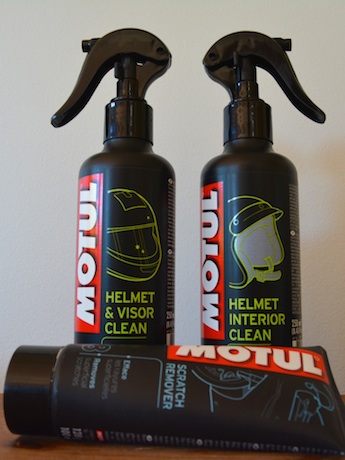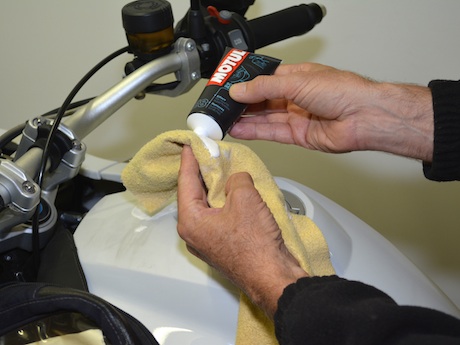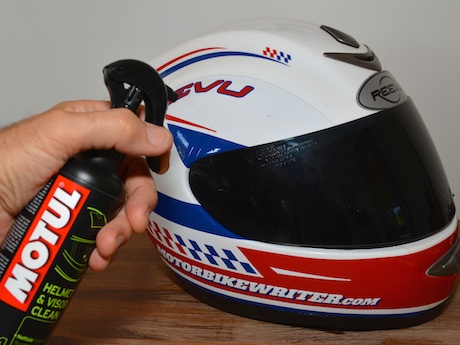Cleaning your motorcycle helmet is not only about pride in your appearance, but also safety, cleanliness, odour and a long life for your most important riding accessory.

Recently I received a few Motul products from Link International to test on my collection of helmets. I thought Motul only made oils, but clearly they do much more.
I’ve tried a lot of motorcycle helmet and visor cleaners in the past and the best is probably water. However, it’s important to make sure there is no grit in the water and that your cloth is clean and soft or you could just be scratching your helmet and visor. Microfibre cloths are best and it’s a good idea to always carry a couple. Make sure you periodically wash them out.
Sometimes water just won’t remove dried bugs and other caked-on road grime, so you need something stronger. Motul’s M1 Helmet & Visor Clean ($11.90 – 100ml) comes in a plastic pump spray bottle which is small enough to fit in a tank bag and won’t break or spill. Spray it on and let it soak in for a while. Then wipe it off with your micro fibre cloth. If you try to wipe it off too soon, it leaves a greasy film. That’s actually an anti-insect film which means that the next time you hit a bug, it won’t stick – you can just wipe it off cleanly with your glove.
I’ve tried household products such as Windex which also works well, but it has a strong smell that has caused my eyes to water. I’ve had no such problems with this product.
I’m always very careful with my helmets, but I still manage to get scuffs on them. I’ve now used Motul Scratch Remover ($9.90 – 100ml) to take some of these scratches off. It won’t perform miracles with big gouges, but it does take off scuff marks, and has cleaned up an area on one helmet where a bluetooth system scuffed the shell. I’ve also used it on my bike to get rid of a scuff market on the tank from the tank bag. It works! In the past, I’ve used toothpaste because it doesn’t have big abrasive particles which can only cause more damage. Likewise, this product has micro-abrasive particles and won’t damage paintwork or your helmet’s shine.

Dab on some of the cream with a soft cloth, spread it over the damaged area, allow it to dry for a few minutes, then rub it off with that ubiquitous microfibre cloth using circular motions. Motul warns about using it in the sun, on hot surfaces or on mat paints. I’d also avoid using it on visors or windscreens where it may cause sunlight to create a “flare” effect.
I’ve also washed a lot of removable liners in motorcycle helmets, but it is not recommended on a frequent basis as it tends to make the helmet fit looser on your head and that is a safety issue. It should remain a tight fit to protect your head on impact. Instead, I now use the Motul M2 Helmet Interior Clean ($11.90 – 100ml) spray. It’s convenient because you don’t have to pull the liner out ands then try to work out how to put it back. Just roll the helmet over and spray inside the helmet. It has a nice odour which isn’t overpowering or flowery. it’s also anti-bacterial so your sweaty head germs won’t fester! You simply spray it on and then leave it to dry before wearing it again. I spray it on nice and thick and leave it overnight. Next morning the grime has disappeared and the helmet feels and smells fresh. Motul claims it has been dermatologically tested and won’t irritate sensitive skin.
- Motul was established in New York in 1853 as Swan & Finch who specialised in lubricants. In 1932, the company moved to France and later became known as Motul. They have claimed several world firsts: In 1953 they produced the world’s first multigrade oil, in 1966 they made the first semi-synthetic oil, 1971 the first 100% synthetic oil with ester, and in 2004 the first double ester technology – 300V engine oils.


